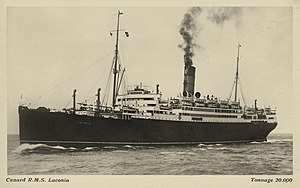RMS Laconia (1921)

RMS Laconia
|
|
| History | |
|---|---|
| Name: | Laconia |
| Owner: |
1921–34: Cunard Line 1934–41: Cunard White Star Line |
| Operator: |
1921–34: Cunard Line 1934–41: Cunard White Star Line |
| Port of registry: | Liverpool |
| Route: | Liverpool – Boston – New York |
| Builder: | Swan Hunter, Wallsend, England |
| Launched: | 9 April 1921 |
| Completed: | January 1922 |
| Maiden voyage: | 25 May 1922 |
| Identification: |
|
| Fate: | Sunk by torpedo 12 September 1942 |
| General characteristics | |
| Class and type: | Ocean liner |
| Tonnage: | |
| Length: | 601 ft 3 in (183.26 m) |
| Beam: | 73 ft 7 in (22.43 m) |
| Draught: | 32 ft 8 in (9.96 m) |
| Depth: | 40 ft 6 in (12.34 m) |
| Installed power: | 6 steam turbines, double reduction geared |
| Propulsion: | Twin propellers |
| Speed: | 16 knots (30 km/h) |
| Capacity: |
|
| Notes: | 10,920,060 cubic feet (309,222 m3) refrigerated cargo space. |
1921–34: Cunard Line
1921–34: Cunard Line
The second RMS Laconia was a Cunard ocean liner, built by Swan, Hunter & Wigham Richardson as a successor of the 1911-1917 Laconia. The new ship was launched on 9 April 1921, and made her maiden voyage on 25 May 1922 from Southampton to New York City. At the outbreak of World War II she was converted into an Armed Merchant Cruiser, and subsequently a troopship. Like her predecessor, sunk during the First World War, this Laconia was also destroyed by a German submarine. Some estimates of the death toll have suggested that over 1,649 people were killed when the Laconia sank. The U-boat commander Werner Hartenstein then staged a dramatic effort to rescue the passengers and the crew of Laconia, which involved additional German U-boats and became known as the Laconia incident.
Laconia was 601 feet 3 inches (183.26 m) long, with a beam of 73 feet 7 inches (22.43 m). She had a depth of 40 feet 6 inches (12.34 m) and a draught of 32 feet 8 inches (9.96 m). She was powered by six steam turbines of 2,561 nhp, which drove twin screw propellors via double reduction gearing. The turbines were made by the Wallsend Slipway & Engineering Company, Newcastle upon Tyne. In addition to her passenger accommodation, Laconia had 54,089 cubic feet (1,531.6 m3) of refrigerated cargo space.
Laconia was built by Swan, Hunter & Wigham Richardson Ltd, Wallsend, Northumberland. Launched on 9 April 1921, she was completed in January 1922. Her port of registry was Liverpool. The code letters KLWT and United Kingdom Official Number 145925 were allocated. As a Royal Mail Ship, Laconia was entitled to display the Royal Mail "crown" logo as a part of its crest. In January 1923 Laconia began the first around-the-world cruise, which lasted 130 days and called at 22 ports.
...
Wikipedia
